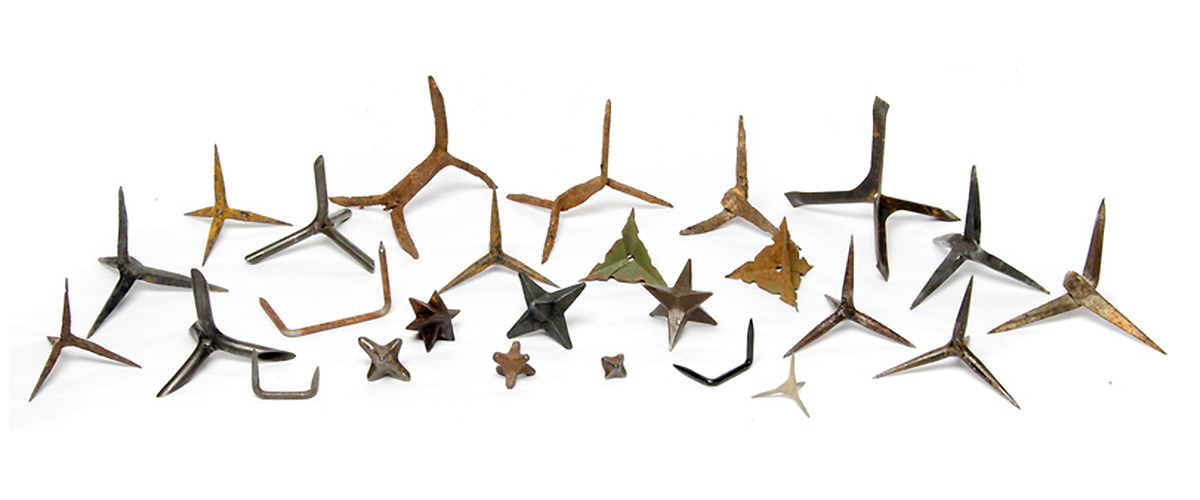The name “caltrop” comes from the Latin word “calcitrapa,” which means “foot-trap.” In the past, caltrops were simple tools that looked like a tetrahedron or metal stars with spikes, and they had four different points. They were spread out across the landscape in a way that made it hard for both infantry and the cavalry to overcome. Caltrops were an important part of old military tactics because they helped forces stop enemy advances, shake up enemy formations, and protect important places. They were also used to strengthen key fixed targets like forts to stop the enemy from moving forward. Caltrops are used as physical barriers in high-security areas as an area denial weapon. They prevent illegal access and protect important infrastructure.
Law enforcement and security workers also use them to stop cars quickly in high-speed chases and other situations where they need to take control of the vehicle quickly. Caltrops are an important part of fighting terrorism, especially when there are hostages or attacks on places that are supposed to be safe. In the past, they were very good at stopping or slowing down an enemy’s infantry force, stopping enemy attacks, and causing chaos on the battlefield. All of these things made them very effective in historic battles. Today, caltrops are used as a weapon because they can be used to break tires and stop cars. They are a useful tool for police and security officers. They can improve security by keeping out people who shouldn’t be there, reducing the movement of vehicles, and putting off possible risks.

In the modern world, alternative security technologies like spike strips and movable fences serve similar purposes to caltrops. Depending on where the conflict is, you may or may not be able to use caltrops for defense. During the time of the Roman Empire, caltrops were used in a number of battles, including the Battle of Carrhae and the Roman attacks on the Celtic tribes in Gaul. The caltrop is an ancient tool that was used in Roman wars and still has a lot of importance today. It was used for the first time in the year 1 BC. In modern uses today when a car runs over a caltrop, the spikes in the caltrop puncture the tires, making the car useless and stopping any advancements.
Even though the U.S. Army doesn’t use caltrops very often anymore, it is still important to know why they aren’t used as much and what options have come up in their place. The evolution of combat has made it possible for important technological advances that have changed the way military methods are used. Modern armed forces use cutting-edge monitoring systems, unmanned aerial vehicles (UAVs), and high-tech devices to find and stop possible attacks. When compared to traditional caltrops, these high-tech devices are much better at covering a large area and giving early warning.
Around the edges of military sites and camps, people are usually more careful these days. In this group are things like strong fences, high-tech entry control, high-definition security cameras, and motion monitors. With these safety measures in place, there will be less need for actual barriers like caltrops to find and stop unwanted entry.
Measures to Control Vehicles: When it comes to controlling vehicles, the US Army has made equipment that works better and faster than caltrops. For example, spike strips are often used by law enforcement and the military to briefly disable cars without putting people in danger. These strips are made of long, retractable spikes that can be quickly placed over a road to deflate tires. They are a controlled way to stop cars without causing major damage or harm.
The goal of modern combat has shifted from weapons that kill to weapons that don’t kill. This is done to make the war less dangerous. Techniques used to control a big crowd include tear gas, shock grenades, and water guns. With these tools, the military can break up groups or scare off would-be attackers without hurting anyone seriously. Due to changes in strategy, the current military policy emphasizes speed, agility, and accuracy in battle. In a fight, you need to be quick and flexible, so physical barriers like caltrops don’t work.
Even though caltrops aren’t used as much as they used to be, that doesn’t mean they aren’t useful or important. The United States Army and other modern military forces used to use caltrops a lot, but they aren’t used as much anymore because of how modern war works, how technology has changed, and how strategic goals have changed. Even though they have these flaws, caltrops can still be useful as weapons in some situations, like when protecting a stationary position from an attack from a moving car.

